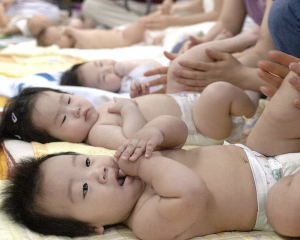South Korea posted the world's lowest birthrate in 2023, but preliminary data out this week shows its fertility rate actually rose last year.
2023年,韩国的出生率在全世界垫底,但本周公布的初步数据显示,韩国2024年的生育率实际上有所上升。
South Korea now offers tax exemptions on childbirth bonuses and other incentives to encourage family growth. This collective effort may be paying off.
韩国现在出台了对生育奖金的免税和其他激励措施,以鼓励家庭增长。这种集体努力可能正在取得成效。
The birth rate reversal this week was its first population growth in nine years -- increased slightly in 2024 to 0.75 from 0.72 in 2023.
这次出生率逆转,是韩国九年来首次出现人口增长--从2023年的0.72略微增加到2024年的0.75。
It's a slight bump -- but still a glimmer of hope for a country facing a potential population crisis.
这是一个很小的增长,但对于一个面临潜在人口危机的国家来说,仍是一线希望。
Hoping to sustain this momentum, the government has set an ambitious target, raising the fertility rate to 1 birth per woman by 2030.
为了保持这一势头,韩国政府制定了一个雄心勃勃的目标,即到2030年将生育率提高到每名妇女生育1个孩子。

So, it's rolled out incentives including a $350 tax cut per person for newlyweds through 2026.
为此,韩国政府推出了包括到2026年为新婚夫妇每人减税350美元在内的激励措施。
But critics like Jung Jae-hoon, a social welfare professor at Seoul Women's University, say the perks aren't enough.
但首尔女子大学社会福利学教授郑在勋等批评人士表示,这些福利还不够。
"There has to be a paradigm shift, towards more democratic, gender-equal family structures, by establishing society-wide childcare systems and family-friendly corporate management."
“我们要通过建立全社会的托儿系统和家庭友好型企业管理,转变模式,朝着更民主、性别平等的家庭结构转变。”
It's too early to tell if all of this will reverse the population crisis.
现在判断这些措施是否可以扭转韩国的人口危机还为时过早。
South Korea's struggle with declining births mirrors similar crises in other developed nations like Japan and Italy, where fertility rates remain stubbornly low despite their own government interventions.
和韩国类似,日本、意大利等其他发达国家也陷入了出生率下降的危机当中,尽管他们自己的政府进行了干预,但生育率仍逗留在低位。



